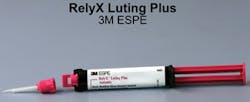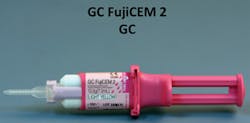Removing zirconia or lithium disilicate crowns
In this monthly feature, Dr. Gordon Christensen addresses the most frequently asked questions from Dental Economics® readers. If you would like to submit a question to Dr. Christensen, please send an email to [email protected].
Q I recently had to remove several lithium disilicate crowns and the procedure was almost impossible. Previously, I have removed some full-zirconia crowns with similar difficulty. Is there an easier technique that I'm unaware of, or is removal of these crowns always difficult?
A Removing lithium disilicate or full zirconia crowns is extremely difficult. However, there are some techniques you can use that make their removal easier and faster. I will discuss some of the techniques for your consideration.
Type of cement
This concept is a preventive one. If you have not used this suggestion, removal of the crowns is difficult regardless of the technique you use. There is an incorrect belief among some practitioners that bonding these two types of crowns is mandatory for strength and retention. I disagree, and have research to back me up. If you were practicing during the era of zinc phosphate cement use, you will agree with the following statement -- zinc phosphate cemented crowns had only mechanical retention, provided by the irregularities made by diamond burs used to cut tooth preparations. They were not bonded!
Zinc phosphate cement is much weaker than resin-modified glass ionomer cement, the most commonly used cement in North America today (Figs. 1 and 2). Did zinc phosphate cemented crowns commonly come off the abutment teeth during service? No, that happened only very infrequently, and then only when the tooth preparations were nonretentive. This empirical evidence alone should add credibility to the statement that bonding is not essential for zirconia or lithium disilicate crowns placed over adequately retentive tooth preparations.
The TRAC division of Clinicians Report (previously CRA) conducted a study on 293 three-unit, zirconia-based fixed prostheses that were cemented with resin-modified glass ionomer (RelyX Luting from 3M ESPE). After nearly 10 years in the mouth, none of the prostheses has come off in service.
I strongly suggest NOT bonding zirconia restorations unless the retention of the tooth preparations is inadequate. If the tooth preparation has at least 4 mm of tooth structure, or adequately retained buildup material, from the gingival line of the tooth preparation to the occlusal table, and the preparation walls are 20 degrees or less from parallelism, there is no reason to bond (Fig. 3). The esthetic result is not negatively influenced if the crowns are at least 1 mm thick (Fig. 4).
If the zirconia crowns are not bonded, but are cemented with resin-modified glass ionomer cement, it is easy to see the cement line demarcation between the crown and the tooth preparation when cutting the crown from the tooth. The color and texture of typical resin-modified glass ionomer cement are different from the color and texture of the crown or the tooth structure. Additionally, the zirconia separates from tooth structure easier if bonding has not been accomplished.
In my opinion, lithium disilicate is also better NOT bonded if the material is at least 1 mm thick and the tooth preparation has adequate retention. Bonding lithium disilicate makes differentiation of the juncture between the restorative material and the crown nearly impossible. Even when taking the greatest care removing the lithium disilicate crowns, the restoration, the resin cement, and the tooth preparation are all the same indistinguishable color, and tooth preparations are often mutilated when removing bonded restorations.
There is an additional and unrelated advantage to luting these restorations with resin-modified glass ionomer — these cements release fluoride ion.
Subgingival margins may increase the esthetic service life of ceramic restorations
This is another preventive concept relative to ceramic restorations. One of the expected reasons for taking off zirconia or lithium disilicate crowns after a few years of service is the inevitable recession of the gingival tissues, leaving an unsightly marginal junction with the tooth structure. The esthetic problem is not as bad with ceramic crowns as with PFMs, where the margins are often dark or chalky, but the margins of some ceramic crowns are still easily discernable to the naked eye.
In cases where gingival recession could produce an undesirable esthetic result, I suggest placing the margins that would be displayed subgingivally. This technique reduces the chance of an unsightly appearance as gingival recession occurs, and potentially increases the esthetic longevity of these crowns.
Cutting OFF the crowns
Many instruments have been designed for cutting off zirconia or lithium disilicate crowns. However, Clinicians Report (CR) research has shown that the use of low-cost, fine-grit diamond instruments, used at high speed, with a very light sawing motion and high water spray, is one of the best ways to remove these crowns. Example diamonds are NeoDiamonds from Microcopy and Solo Disposable Diamonds from Premier Dental. In the CR study, removal of one crown, either luted, nonbonded zirconia, or lithium disilicate crowns, required four slots, four diamonds, and four minutes. Even when luted, the crowns still do not break away from tooth structure similar to porcelain-fused-to-metal or full metal crowns. The ceramic crowns merely chip away piece by piece, and they usually require either cutting the last pieces of restorative material away from the tooth, or using the following technique.
Tapping off remaining ceramic pieces
In spite of improvements over the past several years, bonding agents still have minimal retention to dentin after a brief period of service due to the changing temperature extremes in the mouth. The relatively weak bond is to your advantage. Similar to the technique to remove metal crowns, when removing ceramic crowns, make typical vertical slots in the crown's external surfaces extending vertically from the gingival margin of the preparation to the occlusal surface, and continue over the occlusal surface to the opposite gingival margin.
However, unlike removing metal crowns, where the crown comes off the tooth easily, rotating a screwdriver-shaped instrument in the vertical slot in a ceramic crown removes only a chip of ceramic. Hu-Friedy has a screwdriver-like crown remover instrument, the Christensen crown remover. Usually, several retained chips still remain on the tooth preparation. You can elect to cut off these retained chips, thus destroying another diamond bur or two and potentially harming the tooth preparation. A better removal technique is to use a straight operative dentistry chisel. Place it at the juncture of the remaining chip and the tooth structure. In spite of the bonding agent used, a slight tap on the chisel with a mallet will dislodge the remaining chip.
Refining tooth preparations after removal of the crowns
It is nearly impossible to remove zirconia or lithium disilicate restorations without some mutilation of the tooth preparations, regardless of whether they have been bonded or luted. However, crowns luted with resin-modified glass ionomer cements are more easily removed.
As you would probably expect, plan on refining tooth preparations to remove remaining cement and smooth rough areas on the tooth preparations before making an impression for new crowns.
Summary
There is no question that removal of zirconia, zirconia-based, or zirconia restorations is difficult and time consuming. However, it must be done occasionally. I have suggested luting, not bonding these crowns, when there is adequate restoration thickness and retention, thus allowing easier identification of the cement interface when crowns are removed. The technique to remove any of these crowns is difficult, but use of the technique described will make removal faster and easier.
________________________
More from Gordon Christensen, DDS, MSD, PhD:
- Ask Dr. Christensen: How long should crown therapy be delayed after crown lengthening?
- Ask Dr. Christensen: Can you successfully bleach striated tetracycline stains?
- Ask Dr. Christensen: What are the major needs for small-diameter implants?
________________________
Gordon Christensen, DDS, MSD, PhD, is a practicing prosthodontist in Provo, Utah. He is the founder and director of Practical Clinical Courses, an international continuing-education organization initiated in 1981 for dental professionals. Dr. Christensen is a cofounder (with his wife, Dr. Rella Christensen) and CEO of CLINICIANS REPORT (formerly Clinical Research Associates).
Additional educational resources from Practical Clinical Courses
PCC has several educational videos and courses related to this topic. Call us at 800-223-6569 or visit our website at www.pccdental.com for further information.
Two-day CE Courses:
- Successful, Real World Practice Fixed Prosthodontics
- Successful, Real World Practice Restorative Dentistry
- Christensen Comprehensive -- Affordable Treatment of Complex Cases
Videos:
- Affordable Treatment of Complex Restorative Needs (Item V1964)
- Zirconia & Lithium Disilicate Restorations -- Clinical Comparison and Techniques (V1956)




